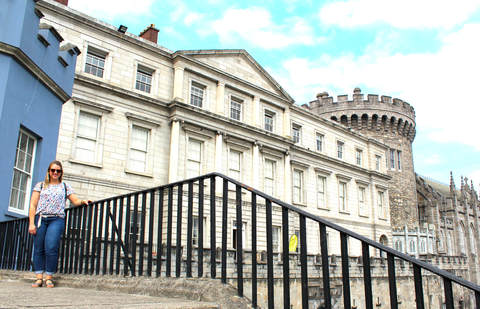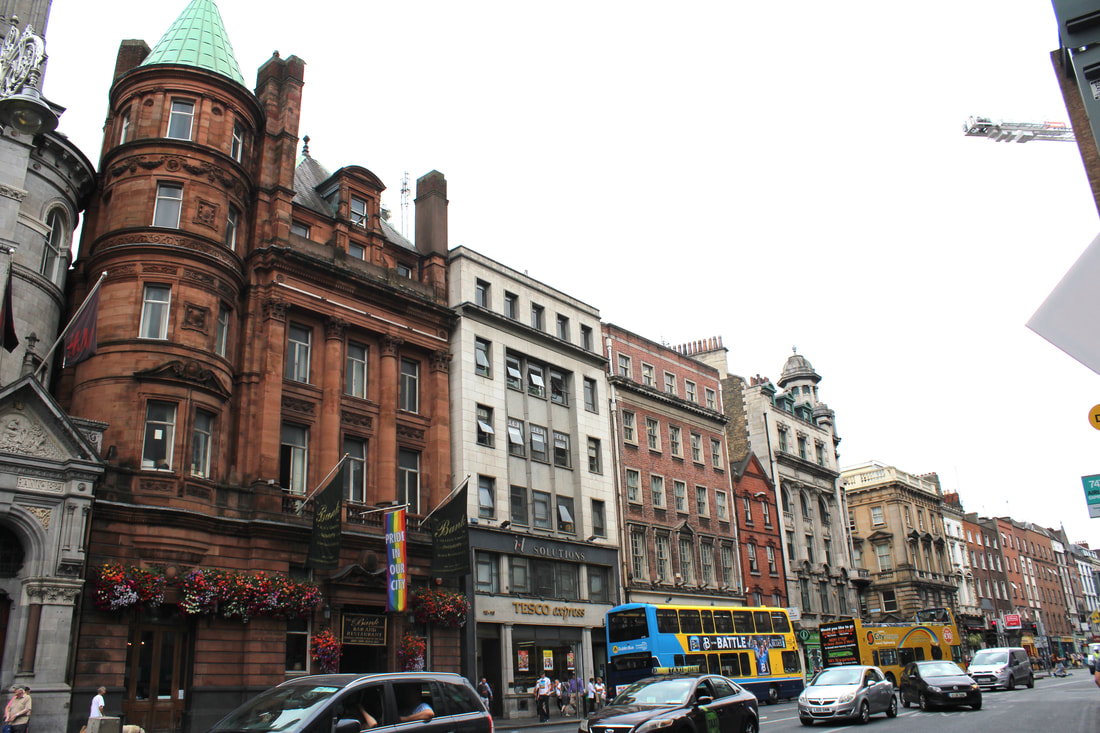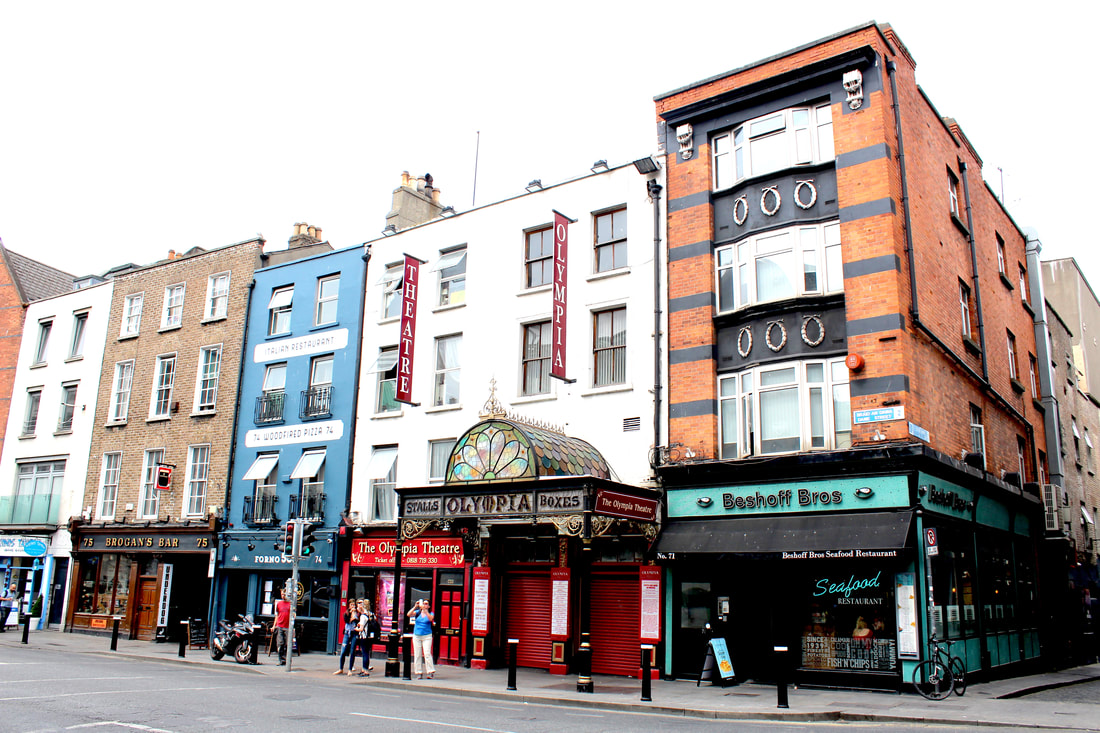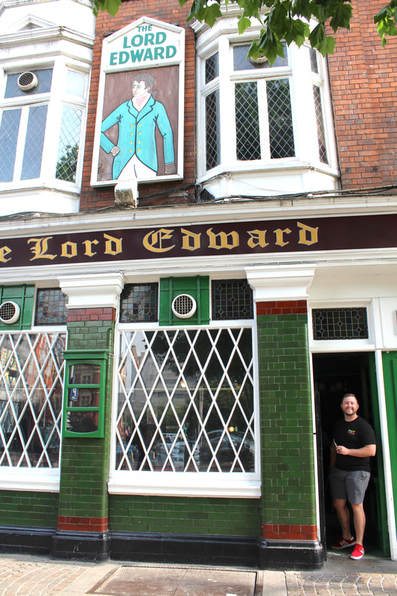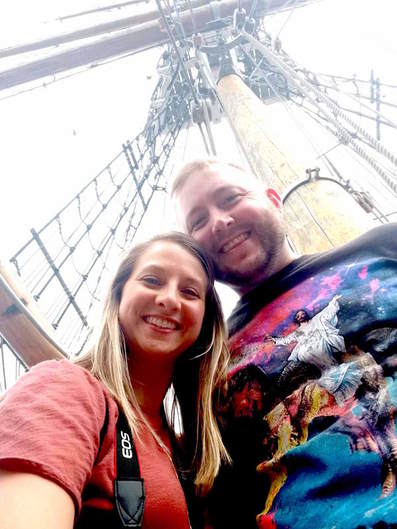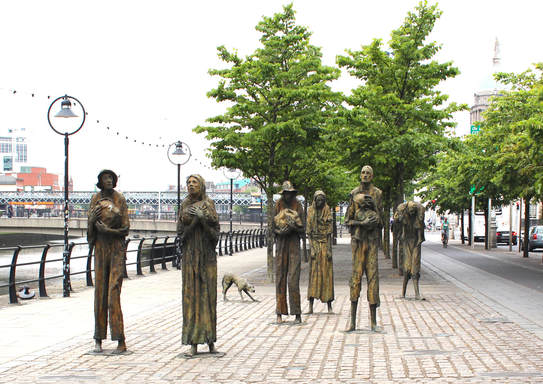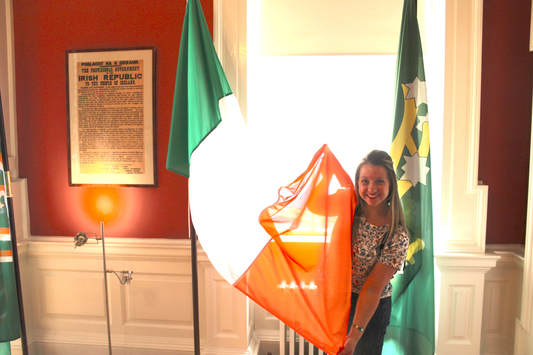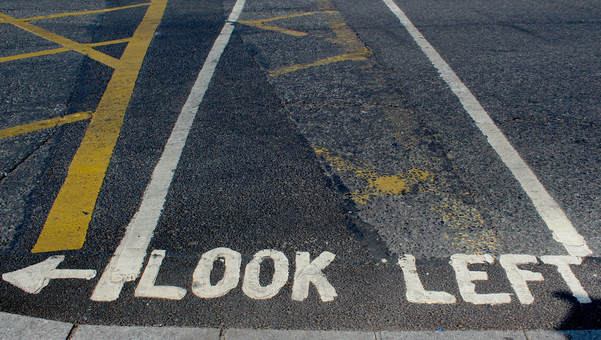|
Our flights to Dublin were uneventful which is always good news. During our one layover (Chicago), we scheduled enough time to leave the airport and meet up with Adam's Chicago family for a bbq dinner. We were airborne and Dublin-bound at dusk and watched the fireworks as our plane was ascending the night sky. The in-flight entertainment offered the musical The Greatest Showman – one of my current favorites. The only negative was the strain of refrain: music fuels my soul and I wasn’t able to burst into song. You’re welcome, fellow UA 152 passengers. The best part of all – I was using a booster seat!!! After years of uncomfortable flights due to my short stature in chairs for average grownups, Adam bought me a booster seat (picture a fancy sofa cushion) which did wonders to lift me to the right sections of the seat back so my chin was no longer pressed into my chest and my shoulders elevated so my arms could sit upon the arm rests. Though my feet dangled a little higher than usual, the rest of me was uber comfy! What a difference it made! We landed on the Emerald Isle around 10 am and made it easily through customs and immigration. We got to our hotel, spiffed up, and headed out. Our first taxi driver was more than eager to be our tour guide. We came to realize that such hospitality and eagerness to showcase the region was standard. We selected the Mercantile for lunch. Adam “asked for” his first “pint of Guinness” here. Let me add, you don’t “order” a beer. And a “glass of Guinness” is a lady’s order. For his meal, Adam selected a Guinness meat pie while I opted for the iconic fish and chips. Our waitresses and the staff of the restaurant were delightfully friendly and entertaining – another characteristic we would see repeated in Ireland. After our hearty lunch, we were off to a self-guided tour of Dublin Castle. While touring through the parliament apartments we learned that only through the guided tour (as in paid extra tour) would we get to explore the interior of the castle. Lucky we've toured a number of castles so we weren't disappointed; however, for travelers headed to Ireland who haven’t, make a note that you may want to book the official tour. As for the castle and grounds, it was built in 1204 and has seen its purpose shift from a home for the ruling class to a military center and then again to a center for social life for the ruling class and the backdrop during colonial rule. In recent times it is used for state events and the presidential inauguration every seven years. Dublin Castle is perched on an overlook of the DubhLinn Gardens. The center of the garden is pruned and shaped into the Celtic knot and has two spiraling brick paths that trace the path the rivers followed. The area the two rivers intersected was called “black pool” or “DubhLinn.” The water has been diverted these days and the area is lush with greenery, flowers, and Celtic art. There are memorials in the garden including one for the Irish police who lost their lives in the line of duty, one for investigative journalist Veronica Guerin who was murdered by drug lords in 1996, and the last commemorating the Special Olympics held in the country in 2003. A short walk up the road is the famed Trinity College. It was founded in 1592 by Queen Elizabeth for the students of Ireland to have their own college much like Oxford and Cambridge rather than them traveling to England. Oscar Wilde began his education at Trinity but transferred to Oxford. Trinity is wildly popular with tourists and thus very crowded; its library is a book lover’s dream. In 1904, Provost George Salmon asserted that women had no business in college and would attend Trinity over his dead body; Salmon died that same year, 1904. Sidebar: For a matter of reference, Yale admitted women in 1969 and Harvard in 1977. Next up, a stroll to Saint Patrick's Cathedral at which our arrival was met with the children's choir practicing. I thought I was in heaven. Unlike the other cathedrals and churches we have visited – adorned with numerous stained glass windows and bright gold – the interior of this gothic cathedral had a dark but gorgeous interior. Built in 1220, it is the tallest church in all of Ireland with its spire reaching 141 feet. Sidebar: Many who aren’t Catholic don’t realize the use of stained glass and statues is to tell stories to people who were illiterate; it is a manner the supports the oral traditions of a culture. In this case, the statuary and windows depict the life of Saint Patrick. According to history, the young Maewyn Succat (future Saint Patrick) was captured and taken as a slave by Irish pirates at 16. Six years later he escaped and managed to make his way back to Britain. Succat returned to Ireland to convert Celtics to Christianity. If you've ever heard the phrase, "to chance your arm," the origin lies here at Saint Patrick. Two feuding families in Ireland made peace through a door, now the Door of Reconciliation, at the church. The Butlers of Ormonde sought refuse at the church. To end the skirmish, the head of the Kildare family asked that a hole be cut into the door, to allow him to stick his arm through to shake hands with the head of the Bulters as a sign of peace. Another interesting note is that the pulpit of John Shift, dean of the church in the 1700s and author of the famous Gulliver's Travels is still present as is the state pew reserved for Ireland's President. The cathedral, although still a working church, is a bit of a history museum for the country. As is customary for me, I gazed upon all the prayer candles, selected one for myself, and lit it with a prayer just as I’ve done while visiting catholic churches about the world. While walking about we happened upon an adorable, contemporary art gallery, Jam Art Factory. Not only did the shop have lovely art for sale, but also art that would make just about anyone giggle or blush. We have a canvas collection at home but seized on the chance to have a piece shipped rather than lugging it around Europe with us. By now it was tea time. We stopped at The Lord Edward for a chat with locals albeit the drink wasn’t exactly a proper tea. A local fellow was already “ossified” and upon hearing we were from Oklahoma, broke into song. His rendition was entertaining to say the least as his Irish accent and slurred speech worked to deliver clearly American lyrics. He was proud of his performance; we tried not to laugh. For dinner, we sought out Darkey Kelly’s at the suggestion of our bartender at The Lord Edward. The dinner was delectable; the waiters were indulgent and funny. We weren’t expecting live entertainment yet there was a three-man show! We clapped our hands, hoot-and-hollered, and stomped our feet. One man played the violin, another sang and played the guitar, while the third played the hand piano... I called it this as I couldn't remember what it was called. Adam is still laughing at me for this one. The restaurant’s back story was on par for the nerdy me: during the 18th century Madam Darkey Kelly ran a brothel here and was later executed for alleged murder of her child. This first half day in Dublin was done. We were “shattered” (exhausted) by this point so we headed back to the hotel, IBIS Dublin. We’d decided on this trip to select lodging that would have a few more creature comforts than our usual Airbnb places. However, our first hotel only had a heater! Thankfully I used my mom's travel hack and packed two battery-powered, portable fans that provided us a little comfort. Sidenote: Breakfast was served the following morning but it was not complimentary. One can't visit Dublin without a trip to a brewery so early the next morning we ventured through the Guinness Brewery in the heart of Dublin. We learned the history of the beer and the factory, smelled the aromas from the ingredients and learned how to taste each one. Perhaps most importantly, we learned how to properly pour a glass (or pint if you’re a fellow) of beer. It was even fun for those like me who don't enjoy the taste of beer. I quite enjoyed the factory's advertising history. Before leaving we made sure not to miss the tasting room at the very top for a 360-degree view of the city. We met a bartender from Portugal here, who loves traveling like us, and explained that, "traveling is an investment in yourself. It teaches you but also those you meet on your travels. It is much better than material things." Of course, we couldn't agree more.
Taxi driver #2 shared with us the history of the EPIC - The Irish Emigration Museum. The museum provided us even more. It’s kind of odd here in Ireland. Yes, the rich history is ever present in records and museums but it can also be felt in the energy of its people – the people we have gotten to know. We were excited to see a familiar face in one of the exhibits – John O'Reilly. His face is on the bottle of one of the 19 Crimes wine flavors. He was banished to a prison in Australia for his participation in the Irish Republican Brotherhood, and later escaped to the US, where he enjoyed a successful career as a writer. After the emigration museum we viewed the Famine Monument and boarded a replica "coffin ship.” Although small, most coffin ships housed many in a small space – the one we boarded took 198 passengers. For about a half a year's wage, a person could purchase a ticket away from Ireland. During the long trip (typically 4 to 7 weeks), the hull where passengers stayed was usually sealed by the crew to contain mutiny and disease. While ships were supposed to have a doctor on board, that was seldom really the case. Location, location, location. It was also true in the coffin ship. It was important to snatch a top bunk and avoid a bunk in the middle or down low. Why? To avoid dealing with the mess that fell when those above you were sick, threw up, or worse. It is believed that 30% of passengers perished along these trips to their new homes. The government stated a doctor would be on board every ship but often this wasn't the case. Chain migration was very popular during this time. A family member who successful migrated earned money and then summoned for another family member to journey to the new home. And on and on this was repeated until whole family units relocated. Unfortunately, the Irish didn’t realize the vastness of the United States and underestimated the challenge of reuniting with family members who managed to survive the journey to the US. Immigration quotas created barriers and were influenced by the unsavory reputation of Irish people. Shipping served as well to relocate orphans to the US. The law in Ireland dictated that a landlord became responsible for children of tenants if the tenants died. Sending orphans to foreign lands was an easy solution for the landlords though it was often a horrendous plight for the orphan. The ship we boarded, the Jeanie Johnston, was an anomaly as the captain reported zero casualties on the total passenger manifests of 2,500 passengers. The captain employed a certified medical doctor as a member of the crew. The doctor tended to passengers suffering from a number of calamities including typhus and cholera thwarting the spread of both throughout the ship. He quarantined the ill and required all passengers to spend at least 30 minutes on deck each day for fresh air. The doctor who was in charge of the Jeanie Johnston continued his work on other vessels but eventually succumbed to disease himself. Such was often the plight of medical professionals in that era. The Potato Famine killed nearly 2 million of the Irish population, but not because there was no food. Yes, the blight (a type of water mold) destroyed the plant leaves and potatoes; and yes, it seemed to be the result of excessive fog. The blight continued for six more years killing roughly 1 million and forcing another million to flee in search of food. The number of starving people was compounded by the population boom in prior years straining families even further as their land wasn’t sufficient enough to produce the quantity of food needed for the larger families. All this heavy talk was taxing! We settled in the Workshop Gastropub for a long-overdue beverage and watched a World Cup game (France v Uraguay). Two well-weathered men took up seats beside us to also enjoy the game. These old timers (each 76 years old!) chattered incessantly with us about their trips to the US during the 60s which we found entertaining and captivating. Heck, one of these fellows was lucky enough to shake the hand of President JFK as he boarded his aircraft! The two proudly shared lots of some random Irish history facts. The Irish language of Gaelic (the oldest and most historic living language in the world) is nearly extinct. The US Choctaw Indian nation sent money to Ireland during the famine! This will definitely be added into my curriculum for Oklahoma history as the tribe is one of the main tribes in the state. Sidebar: Oklahoma is the Choctaw word for “red man.” Adam wanted to visit a Tunisian café and chicha bar named Amir's delight for some Moroccan tea and hookah. I was playing around on Snapchat when I learned and declared out loud that it was International Kissing Day – or póg if you are in Ireland. This got the attention of four friends who appeared to be around our age. They joined our conversation and we all shared travel stories. I was giddy to find they were opera singers! Be still, my heart! More music aficionados! But we couldn't stay in the cafe forever so we bid them slán and made our way to dinner, a place named Boxty. As was expected at this point, the wait service was super friendly. I had ordered wrong for Adam while he made a visit to the jacks (restroom). He wanted to try a boxty (potato pancakes) wrap. The waiter was accommodating saying “We Irish find solutions,” as he surprised Adam with a boxty in addition to the meal I had ordered. As for the boxty, Adam reported it was worth it. We’d signed up for a Writers' Pub Tour, so we scarfed down our food and headed to the Duke. We joined another Irish couple to watch a second futbol game of the day, Brazil v Belgium, as we awaited our tour to begin. The writers' tour escorted us to local pubs that Irish writers such as Oscar Wilde enjoyed, while also speaking and acting in character from some of the writers’ stories. To my surprise, all the tour patrons were Americans though all from different corners. After the tour ended, we remained behind with one of the families sharing travel tips and life stories. As we headed back to our hotel, Adam asked the cab driver for a brief stop at McDonald’s. We broke McDonald’s bread with our newfound friend and then went our separate ways once we were back at our hotel.
We had loads of fun during two jammed-pack days in Dublin, enjoying every minute. Most places sit on sites used by the Vikings which of course was super cool, and we made numerous connections with the locals. We learned that "craik" is their word for "awesome," and we were confused when one taxi driver told us that, "Guiness is craik" and you can get the "best craik in Dublin." As always Adam and I played the slug bug game. I saw two while he saw none, continuing my reign as international champion. If you decide to visit the city make sure to save up. It is pricey! Slancha (cheers) Ireland! I'm already missing your accent, especially those Ts of yours!
0 Comments
|
